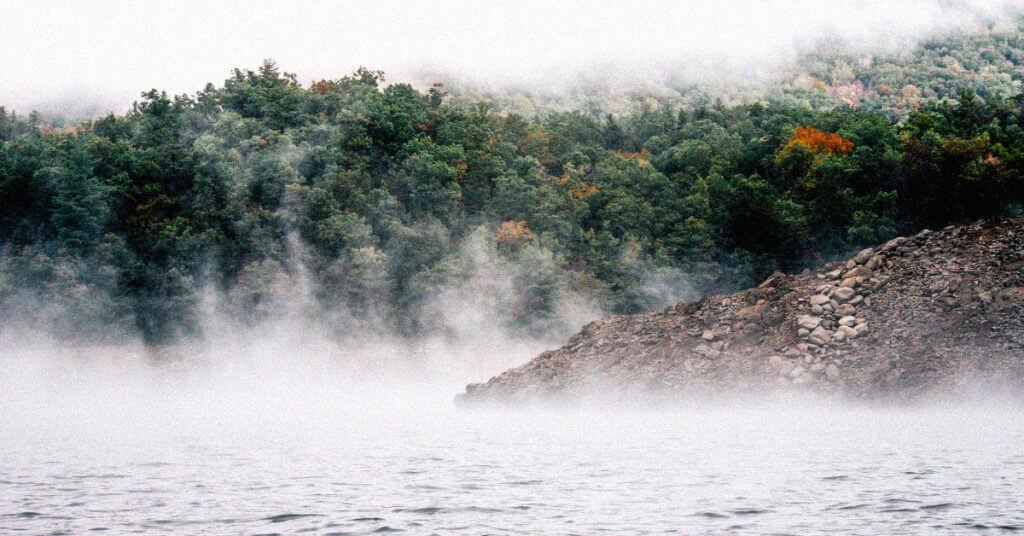The Grand Canyon State is one of those states that everyone should visit at least once in their life. As an angler though, you might be wondering if there is any potential for fishing there?
Don’t let the desert and cacti deceive you. This sun-baked state has plenty of amazing bass fishing and it’s a great destination for anglers all across the country.
We’ve consulted a number of local experts, read through countless forums, and put hours of research into compiling the best bass fishing lakes in Arizona. Let’s do it!
14 Best Bass Fishing Lakes in Arizona: Chosen by Locals
These are the 14 best bass fishing destinations in Arizona that offer tons of excitement to help you make the best fishing memories.
1. Lake Mohave
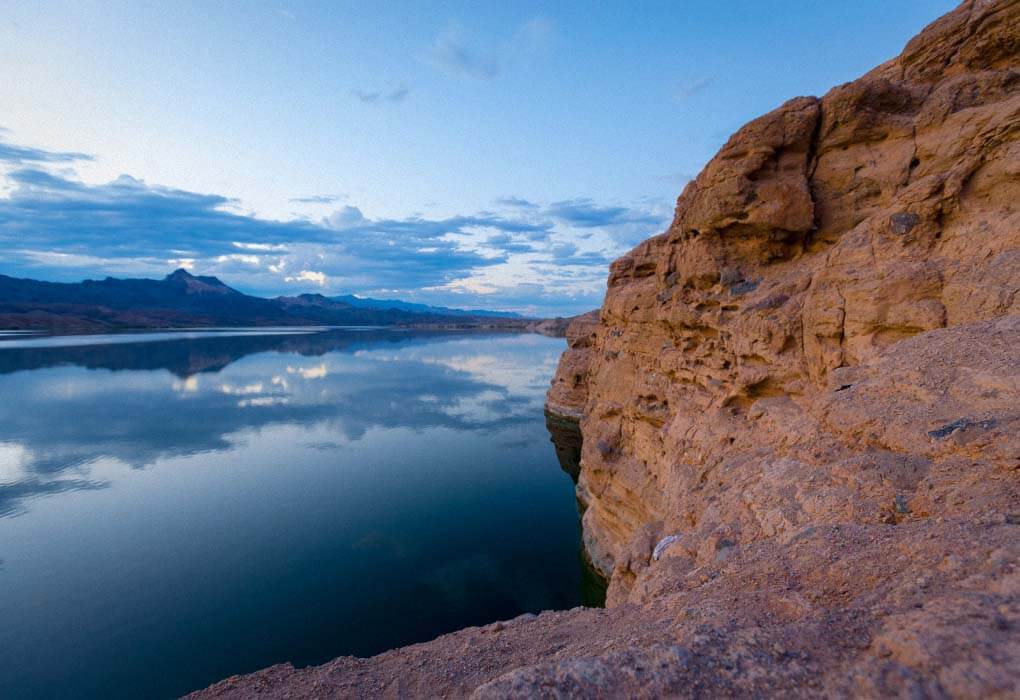
This reservoir is a 67-mile-long stretch of water located south of the Hoover Dam. Along most of its length, the lake is bordered by the steep walls of the Black, Eldorado, Pyramid, and Painted canyons.
The water in the upper 20 miles of the reservoir is colder. The rest of the water remains warmer and the water temperature remains mostly constant throughout the year. This makes it a great spot for bass hunters.
The lake presents a wide range of excellent fishing options for both beginners and pros. Largemouth bass fishing is best between the months of March and June.
The lake also boasts of a healthy population of striped bass. The best period for fishing is between the months of September and October.
The size of the fish in the lake varies. I have seen largemouth as heavy as 8 pounds being fished out of the lake. However, bass above 10 pounds isn’t so uncommon either.
The state record of a 63-pound striped bass was set in this lake. Other than that, black bass up to 4-pounds in weight is also available.
Locals suggest that the best time for bass hunting on the lake is during the morning hours. The coves along the banks are worth exploring with the topwater lures.
Using crankbaits and swimbaits also yields good results. Bank fishing around Willow Beach also delivers good results.
2. Lake Roosevelt

This 21,500-acre Lake is one of the most popular recreational water bodies in Central Arizona. Formed by the Theodore Roosevelt Dam on the Salt River, it has 128 miles of shoreline located within the Tonto National Forest.
While the large volume of water has various fish species. In fact, it’s a favorite destination for anglers looking for the Giant kokanee and walleye.
For bass hunters, the smallmouth to be the star attraction in Lake Roosevelt. Locals mention that the smallmouth population has grown exponentially in the past few years.
The largemouth bass is also available but in relatively smaller numbers.
The size of the smallmouth available is mostly between 6 to 8 inches. This makes Lake Roosevelt a great destination for family fishing trips. The summer months are the best options for bass fishing.
In terms of lures, anglers have found success with the soft plastic baits, especially the worm. Swimbaits and surface lure also deliver good results.
3. Lake Havasu State Park

If you ask veterans about the best smallmouth fishing destination in Arizona, many will direct you towards Lake Havasu.
The 19,300-acre reservoir is formed by the Parker Dam on the Colorado River. It can easily be counted as among the other top bass fishing lakes in the US.
One thing is, the lake is a recreational fishing hotspot and attracts numerous visitors throughout the year. So public fishing docks might be crowded during spring and summer.
Since the water remains clear, it’s a great spot for sight fishing on spawning beds.
To avoid the crowds, you can head to Skier’s Island- one of the best fishing holes on the lake. Or else, explore the fishing docks along the Peninsula Hiking Trail.
If you want to head out on a boat, ask locals about the fish-attracting structures sunk by the Arizona Game & Fish Department.
With a high bass population, the lake is a great destination for inexperienced anglers as well. The submerged rock piles along the shorelines are great spots to look for the smallmouth.
Coming to fishing tips, crankbaits and spinnerbaits work great on bright days when the water is clear.
While smallmouth is the prime attraction, the largemouth bass population isn’t small either. With some luck, you can always hook up some double-digit bass by using soft plastic baits.
The deeper sections of the lake hold some giant striped bass as well.
There are plenty of options for camping around the lake. That makes it a great choice for a weekend fishing trip.
4. Saguaro Lake

If you want to chase the large bass, Saguaro Lake is the perfect spot. Formed by the Stewart Mountain Dam, this lake is another reservoir on the Salt River.
With a surface area of 1,264 acres, it has around 22 miles of shoreline.
The lake is a part of the Tonto National Forest and the jagged rock faces and desert vegetation makes it a picturesque destination.
In fact, the lake offers the best of both worlds for bass anglers and nature lovers.
Largemouth bass around 12 pounds and higher are easily available in the lake. The towering walls of the canyons help to keep the water temperature constant and ideal for summer bass fishing.
The locals suggest heading towards the upper region of the lake where there are large vegetation-filled flats.
The best time to look for trophy bass is between October and December. The period between February and mid-April also remains a good time.
Beyond the bass, channel and flathead catfish, crappies, and bluegill are also found in good quantities.
Be prepared for tackling crowds in the peak of summer though. Also, some sections of the lake are closed to motorized watercraft.
5. Apache Lake

The Apache Lake is 5 miles downstream of Theodore Roosevelt Lake and is also within the Tonto National Forest. The 2,568 acres of crystal-clear waters welcome anglers any time of the year.
It’s a popular destination for water sports in the summer months.
The lake has a healthy population of largemouth as well as smallmouth bass. In addition, it also contains a relatively smaller population of yellow bass.
The average size of the smallmouth is between 3 to 5 pounds. The largemouth can be around 8 pounds or more.
You’ll hardly notice any vegetation in the lake and the bass are mostly found around the rocky bottom. There are plenty of coves, shallows, and water channels in the lake that anglers can explore.
That means topwater lures may not be the best option here. Worms, crankbaits, and jerk baits are good lures during the summer months. When the bass heads deeper, jigs and drop shots are more effective choices.
6. Canyon Lake
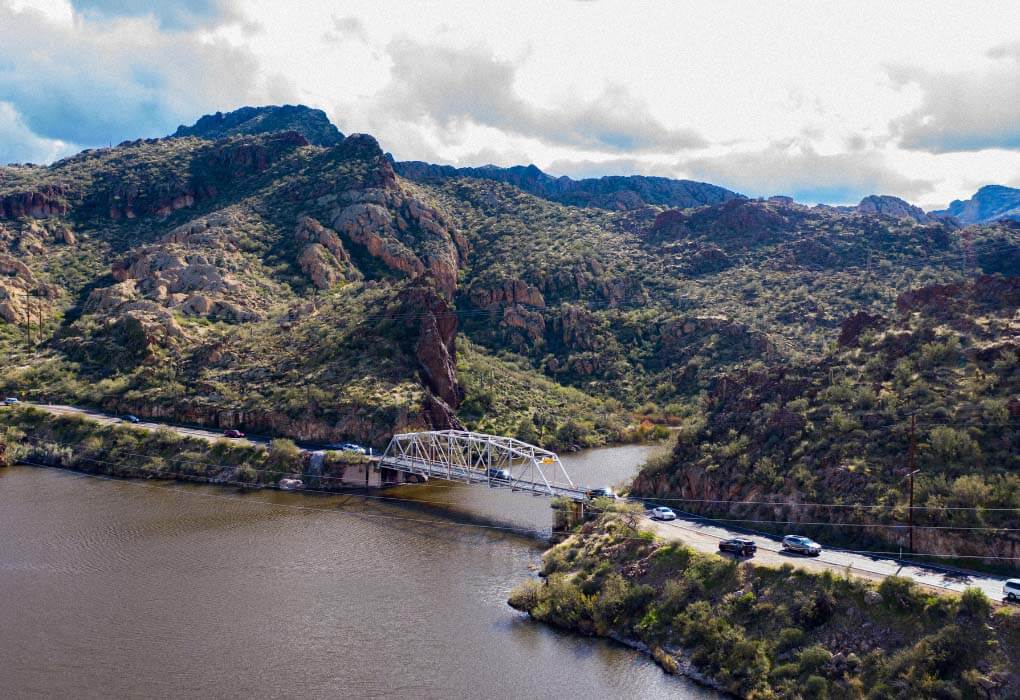
Canyon lake is the smallest among the four reservoirs formed by the dams built on the Salt River. The other three are Apache Lake, Saguaro Lake, and Roosevelt Lake.
With a surface area of 950 acres, the lake is an excellent freshwater fishing destination. It’s also one of the deepest lakes in Arizona with an average depth of 130 feet.
The spectacular view of the canyons from the lake is another attraction.
Canyon lake has always been a popular destination for bass hunters. But some years back the fish population was affected by a strike from flourishing golden algae.
However, the bass population has bounced back in the past few years. The lake is also known for its population of rainbow Trout, crappie, and sunfish.
The main target for anglers is the giant largemouth bass which contains the genetic traits of the Florida Strain of largemouth. A 15-pound largemouth stands as a record catch from the waters.
The waters also contain a good number of smallmouth and yellow bass.
Being close to the Phoenix Metropolitan area, the lake does get crowded in summer. But the good news is, there are plenty of secluded corners where you can take out a boat and look for the bass. Night fishing trips are also possible.
7. Lake Mead
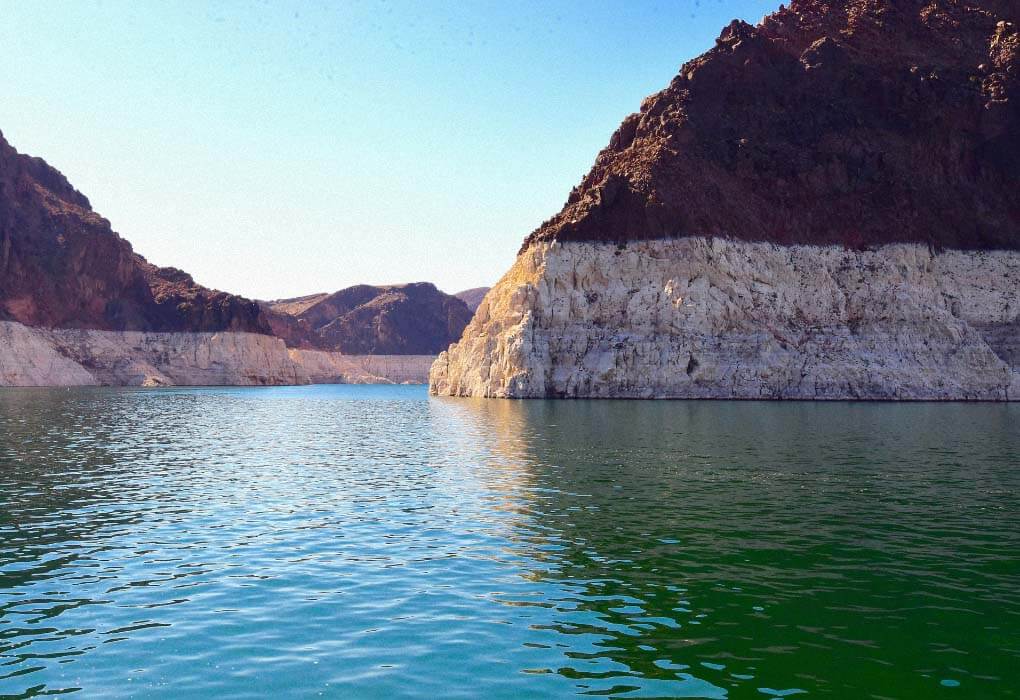
This is a reservoir on the Colorado River with a surface area of 247 square miles and 70 miles of shoreline. The lake is divided into four main basins and the Boulder Basin, which is closest to the Hoover Dam, is the largest.
Lake Mead is most famous for its striped bass population. Occasional catches over 40 pounds have been recorded. Apart from that, it has plenty of largemouth and smallmouth.
The period between May to September is the best time.
The areas around Boulder beach, Willow beach, and Las Vegas Bay are some of the favorite spots for anglers. Look for rocky outcroppings or submerged structures over the rock bottom.
Swimbaits, minnows, and drop shots with live worms are some of the popular lures used here.
Due to the huge size of the lake and hundreds of coves and channels, there’s no lack of fishing spots. You can think of hiring local fishing guides or charter captains to find the best spots.
However, water levels can be low in Lake Mead depending on the weather conditions. So, make the necessary inquiries before you visit.
8. Oak Creek

The Oak Creek ravine is a tributary of the Verde River and flows through the beautiful Oak Creek canyon. It’s located between the cities of Sedona and Flagstaff.
The current is moderate and the water remains cool throughout the year.
The entire stretch of its 12-mile length has the perfect conditions to test your angling skills. Since most parts of the stream are easily accessible, it remains a popular fishing destination.
While the rainbow Trout is the popular target, the creek is loaded with bass too.
Newbies can choose the spots around Mormon’s Crossing and the Chavez Crossing in Sedona. But the best bass fishing spots are in the lower reaches of the creek, below Grasshopper Point.
For smallmouth and largemouth, jigs and soft plastics work well. The period between March to November is the best for bass. Additionally, you can also try fly fishing in the creek.
Note, Oak Creek has different spots that allow catch and release and catch and keep. Check the Arizona Game and Fish website for the latest regulations.
9. Lake Pleasant
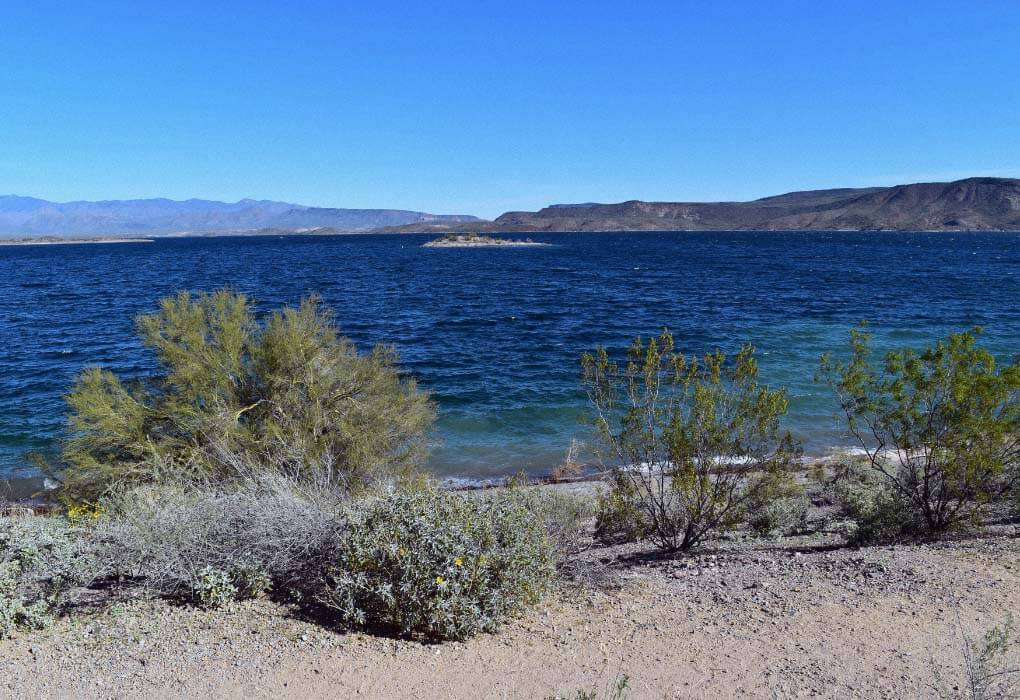
Lake Pleasant is a 10,000-acre reservoir created by the Carl Pleasant Dam and one of the best bass fishing haunts around the Phoenix metropolitan area.
It forms the Lake Pleasant Regional Park, which is a popular outdoor recreational zone.
The lake has three zones that offer a number of highly promising fishing spots to anglers.
The areas around Castle Creek and Humbug Creek have some areas with submerged brush and vegetation that are great spots to look for largemouth bass.
One thing is, the water levels in Lake Pleasant keep varying throughout the year. With frequently changing currents, disappearing and rising islands, the fish too move around frequently in search of food.
That makes locating fishing holes in the lake more challenging.
As per the locals, you can find the Florida-strain largemouth bass in the lake. It’s also the only lake in Arizona with a significant population of white bass.
Some anglers suggest that soft plastic baits aren’t so effective in the lake. Crankbaits, topwater lures, and swimbaits can deliver better results.
Keep in mind, due to its proximity to Phoenix, the lake area remains crowded during the weekends. Choose weekdays to avoid the crowds.
10. Bartlett Lake

Located over the Verde River in Central Arizona, Bartlett lake has a surface area of 2,815 acres. The lake falls within the Tonto National Forest and offers the necessary facilities for camping.
While the scenic views around the lake are a major attraction, it’s also a popular destination for anglers looking for summer bass.
There are plenty of shallow flats, drop offs, pockets, or coves where the smallmouth and largemouth are found.
Generally, baits with a smaller profile work great in the lake. I have also found the areas around the submerged humps to be great spots for using spinnerbaits and crankbaits.
If you’re working from the bank, choose a bait that will get close to the rocky bottom and drag it slowly.
Some locals also mention that the wacky-rigged Senko is one bait the bass can’t resist in these waters.
Bass ranging between 12 to 15 pounds are found commonly in the lake. The US Forest Service has placed multiple fish-habitat structures in the lake to help anglers.
As expected, the best time to go after the big bass is during the early hours of the day.
11. Horseshoe Lake

This reservoir was formed by the Horseshoe Dam and it’s located inside the Tonto National Forest. It has a 790-acre surface area and a shore length of 27 miles. Actually, it’s located a small distance upstream of Bartlett Lake.
Horseshoe Lake is also one of the remotest reservoirs in Arizona. So, you won’t find the best facilities around the lakeside. If you are planning to camp here for a few days, make sure to drive a 4×4 and pack a tent.
Note, unlike other Arizona lakes, the Horseshoe Lake is drained frequently. It’s best to check with the locals before you plan for a boating trip.
Also, debris below the water can make it difficult to paddle. That makes the lake best for bank fishing.
The lake has a healthy population of large and smallmouth bass. The morning hours bring the bass close to the bank and crankbaits and spinnerbaits provide great results.
The fish moves into 10 to 20 feet depth as the sun rises higher. So, Texas rigs with plastic worms or brush hogs work well in those situations.
12. Alamo Lake State Park

This recreational center is centered around Alamo Lake which is fed by the runoff from the Bill Williams River. The lake has all the necessary facilities and also preserves the feeling of remoteness that attracts wildlife enthusiasts.
The lake is one of the most popular Arizona bass fishing destinations in summer and locals mention that the action is incredible. The lake is regularly stocked with a wide variety of fish, including largemouth.
Plenty of anglers have reported catching largemouth above 10 pounds. The bass found here is of the Northern strain so be prepared to tackle their aggression.
That said, bank fishing can be spotty and the bass tends to prefer deeper waters, especially during late winter and early spring. Heading out on a boat is a better option.
The good news is, the bass can be fished in many different ways here. Look for the submerged brush and timber and use a jerkbait, chatterbait, or a jig to bring out the bass.
If there is floating debris, topwater lures or buzzbaits can be good options.
Remember, the water clarity of the lake varies depending on the location. So, choose your lure colors accordingly.
13. Martinez Lake
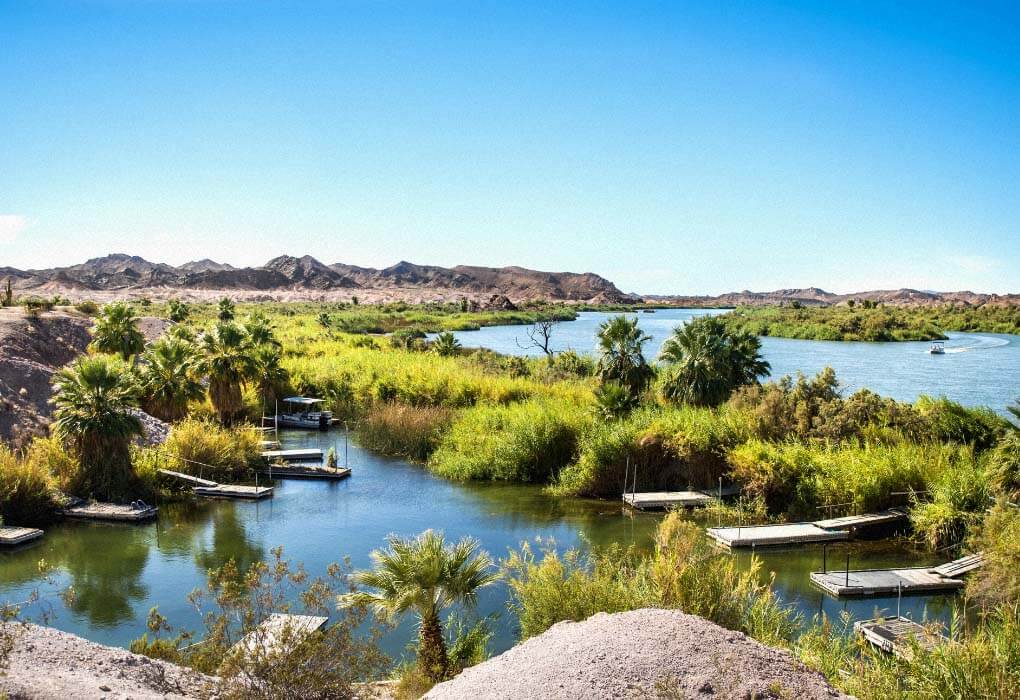
This lake is located on the Lower Colorado River, in the southwestern corner of Arizona. It’s a resort area and multiple bass fishing tournaments are organized each year.
The surface area of the lake can vary between 300 to 500 acres depending on its boundary with the Colorado River.
With a healthy population of smallmouth, largemouth, as well as striped bass, the opportunities for angling are excellent. However, the boat pressure can be high during summer weekends.
On weekdays, you might find yourself spending an entire day on the water without meeting another angler.
The backwaters and the open areas in the lake are great spots where most bass-fishing lures and tactics will work. Many anglers prefer to visit the vegetation along the river banks where it connects with the lake.
Note, this isn’t a haunt for the giant bass. But you will easily find 5 to 6-pounders during spring and summer.
Soft plastics or creature baits work like a charm for attracting the bass lurking in the dense brush around the shoreline. Another successful technique is to use buzzbaits around the clumps of drowned trees in the lake.
14. Patagonia Lake
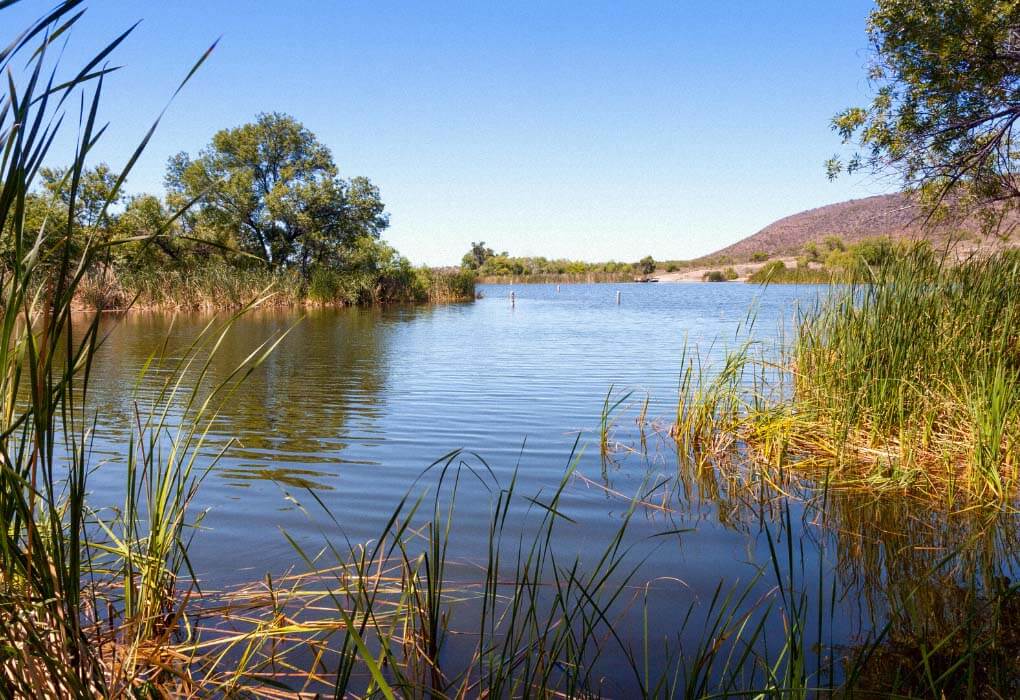
This 265-acre man-made reservoir is located in Santa Cruz County. It’s a hotspot for picnickers and campers with plenty of hiking trails to explore.
You can try fishing from the shore as well as from a boat. Opportunities are good either way. The main attraction is the largemouth bass, which remains active all through the day during summer.
Apart from that, catfish and rainbow Trout are also popular targets.
Since the shorelines have ample cover, there is plenty of shade for the bass to avoid the heat. In fact, Patagonia Lake is also a great spot for night fishing.
Pack spinnerbaits and crankbaits of various colors to match the changing light conditions.
In winter the lake is stocked with rainbow trout, which makes it the ideal trout fishing destination. However, this also results in a feeding frenzy among the largemouth.
Locals suggest using swimbaits that resemble the trout to attract the big bass.
During spring, spawning beds are easy to locate in the shallow sections of the lake. Sight fishing with soft plastic baits is a common practice during this period.
If you prefer bank fishing, a stroll along the lakeside in this period can be a rewarding experience as the bass are easy to locate.
Obviously, catch and release is the best practice in the period to keep the bass population thriving.
Frequently Asked Questions
Is Arizona good for bass fishing?
Arizona is a great destination for bass fishing, and largemouth bass is one of the most popular fish in the state.
In fact, the warm climate of the state makes it the perfect habitat for both largemouth and smallmouth.
That said, less-experienced anglers might find Arizona to be a more challenging bass fishing destination.
Is there bass fishing in Phoenix Arizona?
There are plenty of options for bass fishing in the Phoenix metro area. By commuting a short distance, you can hit some of the bass fishing gems in Arizona.
The premier destination is the Lake Pleasant Regional Park which is less than an hour’s drive from Phoenix.
Other spots like the Surprise Lake, Chaparral Lake, and Tempe Town Lake are also great options for urban anglers.
What is the bag limit for bass in Arizona?
The general daily bag limits as mentioned by the Arizona Game and Fish Department are 6 for largemouth and smallmouth bass and 10 for striped bass.
Before you fish any bass lake, make sure that you have a valid Arizona fishing license and also review the special regulations for the area.
Final Thoughts
Now you know all about the 14 best bass fishing in Arizona that will produce more bass than the other spots.
Arizona offers world-class angling opportunities for bass hunters and some of these bodies of water are the best in the western United States.
No matter the time of the year, you’ll find lakes and reservoirs that offer top-notch bass action.
If you’re looking for other neighboring states with great fishing, check out some of our other reviews:
Enjoy yourself and have fun out there!




